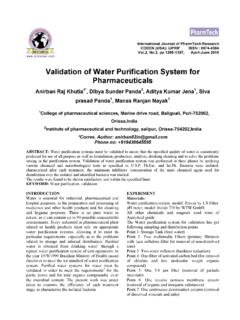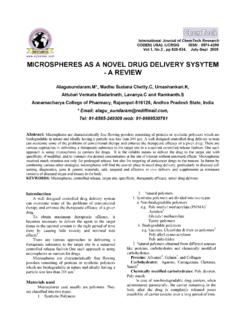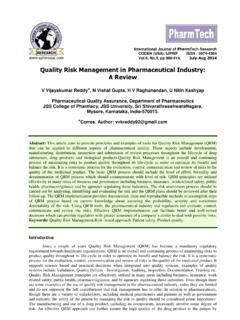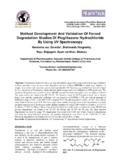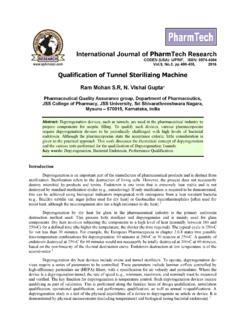Transcription of International Journal ofPharmTech Research - …
1 Sterilization of Porous Loads by Hphv Steam Sterilizer : Mukunda, N. Vishal Gupta*Pharmaceutical Quality Assurance group, Department of Pharmaceutics, JSS Collegeof Pharmacy, JSS University, Sri ShivarathreeshwaraNagara, Mysuru 570015,Karnataka, :The primary objective of proper sterilization of material is very important and alsoensuring that particle and microbiologcal levels are kept below the limits for the chosen gradeof area, as set in the GMP for sterile manufacturing in EU Guidelines. Since it has direct impacton both contamination control and productivity of a sterile manufacturing process, sosterilization of materials is most important in pharmaceutical purpose of this study is to initially develop the sterilization process parameter for theporous load articles then implement the sterilization process for the porous articles.
2 The processdevelopment included qualification of equipment and the results of the tests during the process development were found to be complying with theacceptance criteria for the test performed. Hence, it can be concluded that the process employedfor the development of sterilization process for porous load is SterilizationA process used to render an item free of viable organisms with a specified probability-PDA. Sterilization is an absolute term and implies the total destruction of all forms of microbial life in terms of theirability to reproduce Validated process used to render a product free of all forms of viable microorganisms - ISOS terilizers are used to sterilize many types of articles, including: Porous/hard goods, ,tools, laboratory glassware, product components, packaging, or devices Product components that are not part of porous or liquid load (eg.)
3 Vials and syringes) Cleaning materials and product intermediates Finished products Heat labile media Biological solutions and all methods of sterilization there are two required conditions that must be met in order to assure thatsterilization takes place: Thorough decontamination of medical devices is required in order for the sterilization process to besuccessful. The manufacturers of sterilizers assume that the bio burden, or level of contamination, hasInternational Journal ofPharmTech Research CODEN (USA): IJPRIF, ISSN: 0974-4304 , , pp 374-386, 2016N Vishal Gupta et al/ International Journal of pharmtech Research , 2016,9(3),pp sufficiently reduced on the surfaces of instruments before they are placed in the sterilizer.
4 Sterilizermanufacturers recommend an appropriate kill time, or exposure time, that is based on this assumption The sterilant must come in contact with all surfaces to be sterilized. This means that items must bedismantled according to the manufacturers instructions so that all surfaces are exposed to the variables that affect sterilization include: The dryness of devices to be processed The temperature and humidity of the processing area Whether or not the devices were properly prepared and loaded into the sterilizer Whether or not the sterilant is properly delivered into the system The sterilizer s condition and maintenance protocol Whether or not the correct sterilization method and cycle were used22.
5 Critical Factors [3]Six factors are particularly critical to assure successful steam steam :The exposure time is critical factor simply because all the organisms do not die at the same time. Aminimum amount of time at sterilization temperature is required to kill all the organisms. The number ofsurvivors is usually plotted on a logarithmic typical sterilization cycle will include an exposure phase of at least 20minutes at 1210c for a sterilityassurance level of 10-4, assuming a starting population of one million (106) organisms.
6 This means there is aone in ten thousand (10-4) chance of a single viable Bst spore surviving the process. For each additional 2minutes of exposure at 1210c, the SAL is decreased by a factor of ten. The required SAL varies with theapplication and care should be taken to assure the correct SAL is targeted prior to cycle :The second critical factor in steam sterilization is the temperature of the saturated steam controlled inthe chamber of the sterilizer. The temperature of saturated steam is directly related to the pressure at which it iscontrolled.
7 A typical cycle at 1210c will require 15 to 17lbs of gauge pressure in the chamber of the Moisture:Moisture in the steam has a major impact on its ability to denature, or coagulate proteins; hence theimportance of using saturated steam. Saturated steam is at equilibrium with heated water at the same pressure,which means it contains the maximum amount of moisture without liquid condensate present. Saturated steamis recommended for steam sterilization. Superheated steam, steam containing excessive liquid water, and steamcontaining excessive boiler additives or contaminates should be avoided.
8 Superheat occurs in steam distributionsystems when the line pressure is dropped across a Pressure Reducing Valve (PRV). The larger the pressuredrop, the more superheat is created. Superheat does not contain the required moisture necessary to assuresterilization. The excess energy in superheated steam is transient and is eventually dissipated by the items in thesterilizer chamber, but can cause difficulty when validating the sterilizer to the empty chamber Vishal Gupta et al/ International Journal of pharmtech Research , 2016,9(3),pp Direct steam contact:Direct steam contact with the surface of the object to be sterilized is required for the steam to transferits stored energy to the object.
9 Without direct steam contact to all surfaces, the item will not be sterilized. Theamount of energy stored in steam is much higher than dry air or water at the same Air removal:Air is the biggest deterrent to steam sterilization. Air must be removed from the chamber and the loadbefore direct steam contact and sterilization can occur. This is accomplished in a steam sterilizer by a series ofvacuum pulses prior to sterilization (pre-conditioning phase). A small amount of air will always be present inthe autoclave chamber, but must be minimized.
10 Insufficient air removal, sterilizer chamber vacuum leaks andpoor steam quality (excess non-condensable gases) are the most common causes of sterilization :Wrapped items must be dry before they can be aseptically removed from the sterilizer. Condensation isthe natural result of steam contact with the cooler surfaces of the load during the heating and exposure presence of condensation (wet packs or pouches) can cause re-contamination of the load when removedfrom the sterilizer. A steam sterilizer dries the load after sterilization by drawing a deep vacuum in the chamber(post-conditioning phase).
